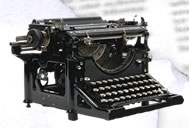A short notice reporting on the 1917 death of Count Ferdinand Adolf August Heinrich Von Zeppelin (b. 1838). The count is reported to have died a sad and broken man over the failure of his airships to hasten a decisive ending to the First World War and remorseful that his name would forever be associated with the first air raids on civilian targets.
Two LITERARY DIGEST articles, printed seven days a part, addressing the topic of the destruction of the U.S. military's semi-rigid airship, ROMA; much attention is paid as to where the blame for the disaster must be placed. The journalists concur that the U.S. Congress was answerable for the loss due to that body's unwillingness to pay for the necessary helium, rather than the less expensive, and highly flamable, hydrogen gas. Thirty-four lives were lost.
A New York Times photograph and report on the military dirigible designed by Italian Senator Enrico Forlanini (1848 - 1930). A concise account of the differences between Forlanini's dirigible and the German Zeppelin are listed as well as the speed, altitude and various offensive capabilities. Enrico Forlanini is is best remembered today for his ground breaking work on steam-powered helicopters, hydrofoils and various other aircrafts, such as his 1909 dirigible, Leonardo Da Vinci<\i>.
Pictured herein is the French dirigible ADJUDANT REAU as it appeared during the first months of the First World War.
Also depicted are two early tri-planes which were used to help elevate the craft.
A 1921 article from The Independent reported on the accident that doomed the dirigible Z-R2 in the skies over the British town of Hull. This British-built R-38 class airship was to be handed-over to the U.S. Navy and had a mixed crew composed of both Yanks and Brits; five of whom survived. Among the dead was Air-Commodore E.M. Maitland (b. 1880).
A black and white photograph depicting the gondola interior of the German zeppelin 49, that was brought down over Bourbonne-les-Bains, France in 1917. At the center of the image is the pilot's wheel and off to the right sits the zeppelin's bombsite.
A schematic plan of a German World War One Zeppelin that illustrates the airship's bombay, crew quarters and gondola.
Attached are two wartime illustrations from a French magazine that depict the artist's understanding of the frantic life on board a zeppelin that is under attack from enemy aircraft.
"Just before dark, the $2,450,000
Macon had lurched crazily and inexplicably skyward, then had settled stern first into the sea. All but the chief radio operator and a Filipino mess-boy among the eighty-three officers and men aboard had taken to rubber life boats and had been picked up by war ships on Maneuvers."
"All Congress needs to do is announce its refusal to condemn more American seamen to death; to declare that no more funds of American taxpayers will be squandered on these useless gas-bags."
Click here to read about a much admired American aviator who was attracted to the fascist way of thinking...
1929 saw the creation of the U.S. Navy airship ZMC-2, the first metal dirigible (aluminum alloy) of its kind:
"Heretofore, the trend in dirigible construction has been toward larger and longer ships; the egg-shaped ZMC-2 can withstand the buffeting of the winds much better than her larger and more unwieldy sister ships."
Built by the Aircraft Development Corporation (Detroit), ZMC-2 was in use by the U.S. Navy until her retirement, in 1941.
This article from a 1937 issue of The Magazine of Art addressed the over-all aesthetic appeal of the Hindenburg' . Written by Blanche Naylor, no stranger to all matters involving industrial design of the Thirties and Forties, the article goes into some detail as to the color scheme, upholstery, paintings and the names of the assorted German designers responsible for the beauty of the air-ship. The article is accompanied by seven photographs and one diagram of the public rooms accessible to the Hindenburg' passenger's.
Pieced together from the captain's log as well as various first-hand observations that were called to mind by the 29 surviving crew members, this article presents a blow-by-blow account as to how the U.S. Navy dirigible
Shenandoah was overwhelmed by turbulent winds over Eastern Ohio and torn in two.
"As they climbed into the hull, the ship began spinning counter-clockwise on its keel, then lifted its nose and shot upward. Girders groaned and wires snapped. Then came a crunching, sickening roar as the girders parted. The ship had broken in two. Another rending crash and the control car plunged earthwards, carrying Lt. Commander Landsdowne and seven other men to their death."
America's foremost authority on lighter-than-air craft, Rear Admiral Charles Rosendahl (1892 – 1977), tells you why this country should build and operated dirigibles if we are to maintain our rightful place in the field of post-war air transportation (they decided to build jets instead).
